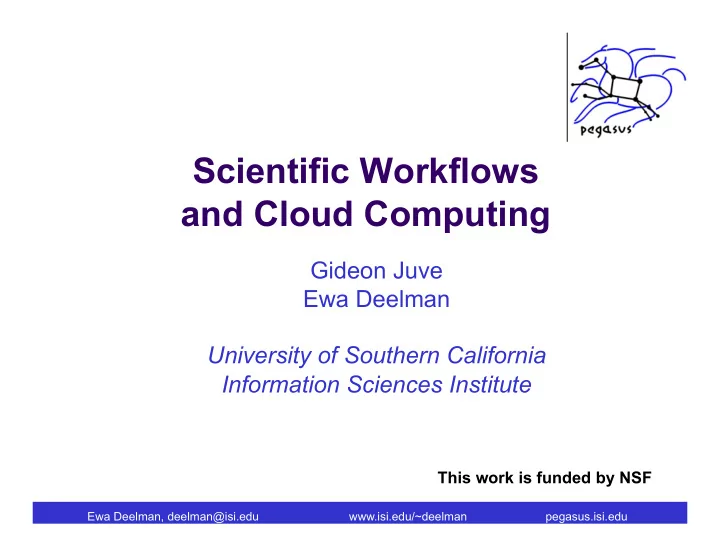

Scientific Workflows and Cloud Computing Gideon Juve Ewa Deelman University of Southern California Information Sciences Institute This work is funded by NSF Ewa Deelman, deelman@isi.edu www.isi.edu/~deelman pegasus.isi.edu
Computational challenges faced by science applications Be able to compose complex applications from smaller components Execute the computations reliably and efficiently Take advantage of any number/types of resources Cost is an issue Cluster, Cyberinfrastructure, Cloud Ewa Deelman, deelman@isi.edu www.isi.edu/~deelman pegasus.isi.edu
Possible solution somewhat subjective Structure an application as a workflow (task graph) Describe data and components in logical terms (resource independent) Use a Workflow Management System to map it onto a number of execution environments Optimize it and repair if faults occur--the WMS can recover Use a WMS (Pegasus-WMS) to manage the application on a number of resources Ewa Deelman, deelman@isi.edu www.isi.edu/~deelman pegasus.isi.edu
Pegasus-Workflow Management System (est. 2001) Leverages abstraction for workflow description to obtain ease of use, scalability, and portability Provides a compiler to map from high-level descriptions to executable workflows Correct mapping Performance enhanced mapping Provides a runtime engine to carry out the instructions (Condor DAGMan) Scalable manner Reliable manner Can execute on a number of resources: local machine, campus cluster, Grid, Cloud Ewa Deelman, deelman@isi.edu www.isi.edu/~deelman pegasus.isi.edu
So far applications have been running on local/campus clusters or grids SCEC CyberShake Uses physics- based approach 3-D ground motion simulation with anelastic wave propagation Considers ~415,000 earthquakes per site <200 km from site of interest Magnitude >6.5 Ewa Deelman, deelman@isi.edu www.isi.edu/~deelman pegasus.isi.edu
Applications can leverage different Grids: SCEC across the TeraGrid and OSG with Pegasus SoCal Map needs 239 of those MPI codes ~ 12,000 CPU hours, Post Processing 2,000 CPU hours Data footprint ~ 800GB Peak # of cores on OSG 1,600 Walltime on OSG 20 hours, could be done in 4 hours on 800 cores Ewa Deelman, deelman@isi.edu www.isi.edu/~deelman pegasus.isi.edu
Some applications want science done “now” Looking towards the Cloud—they like the ability to provision computing and storage They don’t know how to best leverage the infrastructure, how to configure it They often don’t want to modify the application codes They are concerned about costs Ewa Deelman, deelman@isi.edu www.isi.edu/~deelman pegasus.isi.edu
One approach: Build Virtual Cluster on the Cloud Clouds provide resources, but the software is up to the user Running on multiple nodes may require cluster services (e.g. scheduler) Dynamically configuring such systems is not trivial Some tools are available (Nimbus Context Broker– now Amazon cluster with mapreduce) Workflows need to communicate data—often through files
Experiments Goal: Evaluate different file systems for VC Take a few applications with different characteristics Evaluate them on a Cloud—single virtual instance (Amazon) Compare the performance to that of a TG cluster Take a few well-known file systems, deploy on a virtual cluster Compare their performance Quantify monetary costs Ewa Deelman, deelman@isi.edu www.isi.edu/~deelman pegasus.isi.edu
Applications Not CyberShake SoCal map (PP) could cost at least $60K for computing and $29K for data storage (for a month) on Amazon (one workflow ~$300) Montage ( astronomy, provided by IPAC ) 10,429 tasks, 4.2GB input, 7.9GB of output I/O: High (95% of time waiting on I/O) Memory: Low, CPU: Low Epigenome ( bioinformatics, USC Genomics Center ) 81 tasks 1.8GB input, 300 MB output I/O: Low, Memory: Medium CPU: High (99% time of time) Broadband ( earthquake science, SCEC ) 320 tasks, 6GB of input, 160 MB output I/O: Medium Memory: High (75% of task time requires > 1GB mem) CPU: Medium
Experimental Setup Cloud Grid (TeraGrid)
Resource Type Experiments Resource Types Tested Amazon S3 • $0.15 per GB-Month for storage resources on S3 • $0.10 per GB for transferring data into its storage system • $0.15 per GB for transferring data out of its storage system • $0.01 per 1,000 I/O Requests
Resource Type Performance, one instance
Storage System Experiments Investigate different options for storing intermediate data Storage Systems Local Disk NFS: Network file system PVFS: Parallel, striped cluster file system GlusterFS: Distributed file system Amazon S3: Object-based storage system Amazon Issues Some systems don’t work on EC2 (Lustre, Ceph, etc.)
Storage System Performance NFS uses an extra node PVFS, GlusterFS use workers to store data, S3 does not PVFS, GlusterFS use 2 or more nodes We implemented whole file caching for S3
Lots of small files Re-reading the same file
Resource Cost (by Resource Type) Important: Amazon charges per hour
Resource Cost (by Storage System) Cost tracks performance Price not unreasonable Adding resources does not usually reduce cost
Transfer and Storage Costs Transfer Costs Transfer Sizes Transfer costs are a relatively large fraction of total cost Costs can be reduced by storing input data in the cloud and using it for multiple runs Input data stored in EBS VMs stored in S3 Image Size Monthly Cost 32-bit 773 MB $0.11 64-bit 729 MB $0.11
Summary Commercial clouds are usually a reasonable alternative to grids for a number of workflow applications Performance is good Costs are OK for small workflows Data transfer can be costly Storage costs can become high over time Clouds require additional configurations to get desired performance In our experiments GlusterFS did well overall Need tools to help evaluate costs for entire computational problems, not just one workflows Need tools to help manage the costs Or use science clouds like FutureGrid
Acknowledgements SCEC: Scott Callaghan, Phil Maechling, Tom Jordan, and others (USC) Montage: Bruce Berriman and John Good (Caltech) Epigenomics: Ben Berman (USC Epigenomic Center) Corral: Gideon Juve, Mats Rynge (USC/ISI) Pegasus: Gaurang Mehta, Karan Vahi (USC /ISI) Ewa Deelman, deelman@isi.edu www.isi.edu/~deelman pegasus.isi.edu
Recommend
More recommend